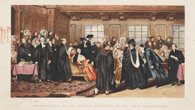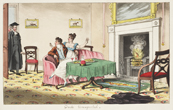Students at work and play
 |
| Swimming Club members at the bathing sheds on the Cam, ca 1924 (UA SOC.90.7.4) |
Early students followed a pattern pioneered in Paris, attending lectures given by regent masters and copying and expounding texts. The liberal arts course for the BA and MA comprised grammar, rhetoric and logic (the trivium), arithmetic, music, geometry and astronomy (the quadrivium) and philosophy. Doctoral study embraced theology, law and medicine. From the mid-eighteenth century mathematics gained prominence, embodied in the sole honours course for the BA until 1822, the Mathematical Tripos. The current panoply of tripos subjects for undergraduates - from Classics to Computer Science - developed from the mid-nineteenth century, as modernisers embraced new disciplines and expanded teacher numbers. Medieval and later examinations were oral disputations. Written examinations, first introduced by colleges, came to be adopted centrally by about 1800.
The exuberance of youth is a given and rules have always been framed for its control, inside and outside the classroom. Students have socialised in legitimate and less legitimate ways; from the mid-nineteenth century increasingly via clubs and societies, whether sporting, musical, political, theatrical, ephemeral or long-lasting.
Click to view larger images:


